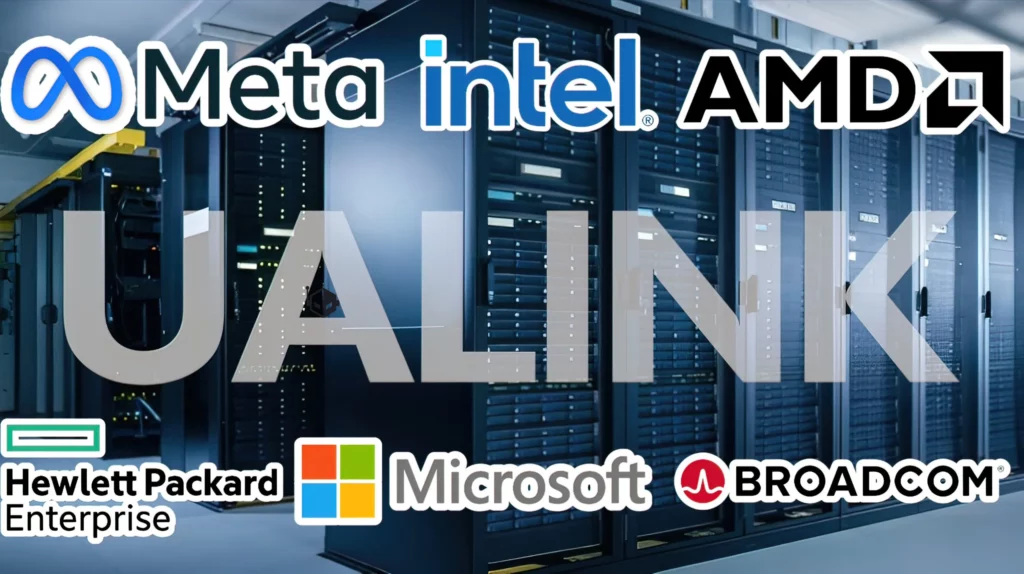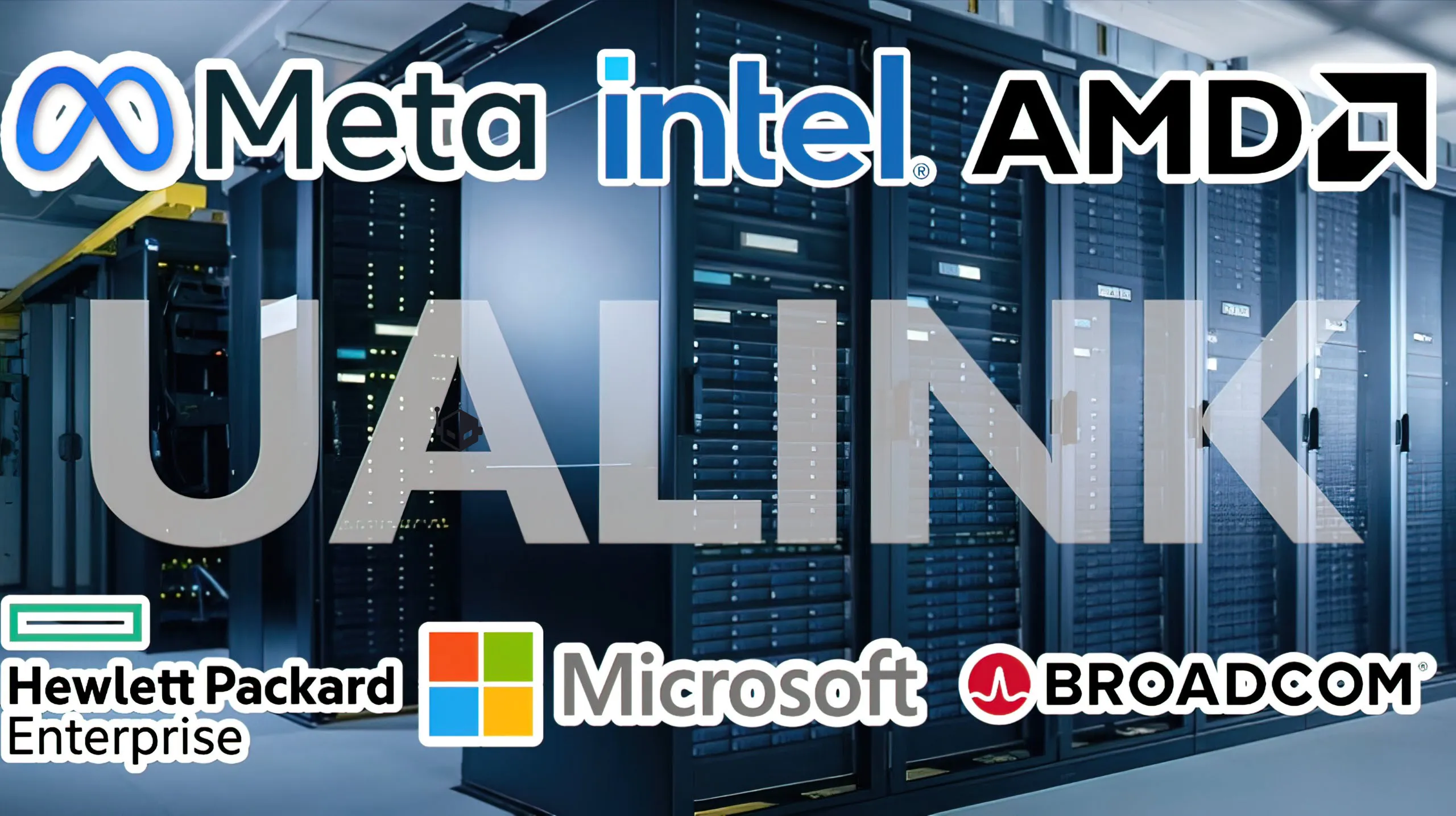
Introduction
The tech world is abuzz with the news of a formidable alliance. The likes of Google, Intel, Microsoft, AMD, and more have assembled to challenge Nvidia’s stronghold on AI hardware interconnect technology. Nvidia’s NVLink has been the gold standard, facilitating rapid communication between AI chips and bolstering the company’s dominance. However, the formation of the Ultra Accelerator Link Promoter Group signals a potential shift in the landscape.
NVLink: Created by Nvidia, it’s a proprietary interconnect technology that allows high-speed communication between multiple Nvidia GPUs. This enables faster training and processing of complex AI models.
UALink:A consortium of companies, including AMD, Intel, Google, Microsoft, and Broadcom, is developing UALink, an open-standard interconnect. It aims to achieve high-speed communication similar to Nvidia’s, but with a key difference: UALink is designed to be compatible with various AI accelerators from different vendors.
Here’s why this fight matters:
Openness vs. Control: NVLink keeps Nvidia in control of its ecosystem, potentially limiting innovation from other players. UALink promotes open standards, fostering competition and potentially accelerating advancements in AI hardware.
Scalability: Both technologies enable connecting multiple AI accelerators, but UALink boasts the potential to connect a much larger number (up to 1,024) compared to NVLink. This could be crucial for building massive AI clusters needed for complex tasks.
Vendor Choice: With UALink, data centers wouldn’t be restricted to Nvidia hardware. They could mix and match accelerators from different vendors based on performance and cost.
It’s still early days for UALink, with its first version expected later this year (2024).
Follow us on Linkedin for everything around Semiconductors & AI
The Need for UALink
The rise of artificial intelligence (AI) has pushed the boundaries of computing power. Complex algorithms require massive datasets and hefty processing muscle. Here’s where the concept of an interconnect comes in. Think of it as a superhighway connecting multiple processors – GPUs (graphics processing units) and specialized AI accelerators – allowing them to share data seamlessly.
Currently, Nvidia’s proprietary NVLink reigns supreme in the interconnect arena. It offers 100 GB/s connections and a total bandwidth of 1.8 TB/s per single GPU, but with a catch: it’s exclusive to Nvidia hardware. This has positioned Nvidia as the leader in AI hardware, with their Blackwell GPUs being the go-to for demanding AI tasks.
Enter UALink, the brainchild of a tech industry dream team. This open-source interconnect standard aims to level the playing field. By creating a universal language for processors to communicate, UALink empowers manufacturers to design compatible hardware, fostering a more competitive landscape.
Read More: RM 6 Billion Investment: SPIL New Factory to Create Nearly 3,000 Jobs in Penang – techovedas
The New Contender: UALink
Will UALink dethrone the mighty NVLink? Here’s what the current landscape says:
UALink’s open-source framework has the potential to democratize AI hardware development. But Nvidia’s NVLink holds an advantage due to its maturity and optimization for specific hardware configurations.
Nvidia already has a head start with established NVLink technology and a strong presence in the data center market. UALink needs to gain widespread adoption and ensure compatibility with upcoming AI accelerator architectures.
However, the combined resources, expertise, and influence of companies like Google, Intel, Microsoft, and AMD could accelerate the development and adoption of UALink. Moreover, UALink has potential to integrate up to 1,024 GPUs within a single computing pod. It’s based on technologies like AMD’s Infinity Architecture, suggests significant improvements in speed and reduced data transfer latency.
Takeaways From NVLink vs UALink
The battle for interconnect standards goes beyond raw performance. Here are some long-term implications of this rivalry:
Open-Standard Advantages: Standardizing UALink for AI and HPC accelerators will empower system OEMs, IT professionals, and system integrators to integrate and scale AI systems in data centers with greater ease.
Ultra Ethernet and CXL: UALink’s development is intertwined with other technologies like Ultra Ethernet and the Compute Express Link (CXL) based on PCIe 5.0. These technologies could play a role in the future interconnect landscape, influencing how AI clusters are networked.
Market Dynamics: Nvidia’s acquisition of Mellanox and its established NVLink technology give it a strong current market presence. However, the UALink consortium’s push for an open standard could shift market dynamics, challenging Nvidia’s proprietary approach.
Timeframe for Implementation: It’s important to note that UALink is not expected to be an immediate disruptor. The implementation target for UALink as a mature product is likely beyond 2025, indicating that NVLink will remain relevant for the near future.
Read More: Huawei Surpasses Samsung to Become Top Foldable Smartphone Maker in Q1 2024 – techovedas
Conclusion
The formation of the Ultra Accelerator Link Promoter Group and the development of UALink challenge Nvidia’s uncontested position as the frontrunner in AI hardware, pushing the industry towards a more collaborative and open future. It’s a bold move that could reshape the AI hardware market, fostering innovation and competition








